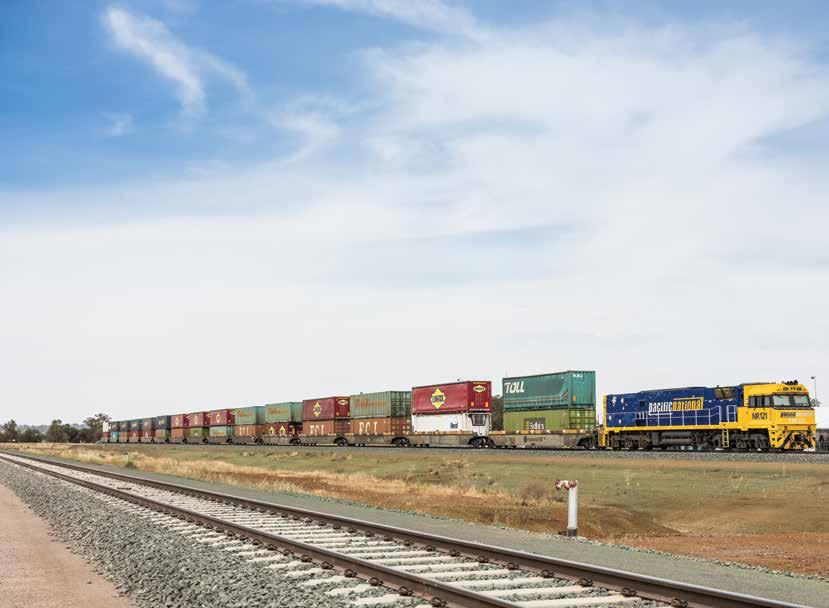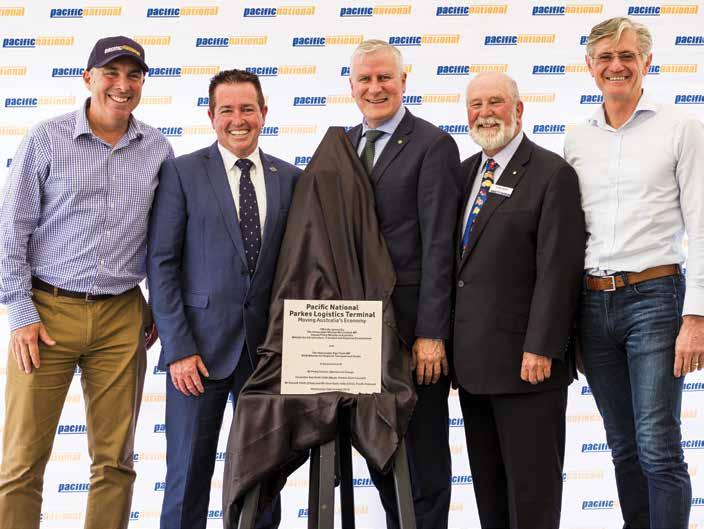
6 minute read
Pacific National opens new Parkes freight hub
from REX Dec 2019
by Prime Group
‘Historic day’: PN opens Parkes Logistics Terminal

Pacific National has opened its new Parkes Logistics Terminal in a landmark commitment to Inland Rail and the freight rail sector.
The importance of Parkes as a future intersection of two of Australia’s most significant railways is not just understood by Pacific National. All three levels of government have recognised the same thing.
Parkes Shire Council leapt on the opportunity in February 2018 and established the Parkes National Logistics Hub campaign, to encourage investment by logistics operators and customers. A year later, the NSW state government declared the area a special activation precinct, enabling O N A SUNNY DAY IN OCTOBER, more than 100 government, private sector and local representatives gathered for the opening of Pacific National’s Parkes Logistics Terminal. Just a few years earlier, the land where they stood was a sheep paddock. But after 12 months of construction, more than 16,000 cubic metres of soil moved, over 300 cubic metres of concrete poured, and 253 tonnes of aggregate laid, the paddock had been transformed into regional Australia’s largest logistics terminal.
A $35 million rail hub complete with two 1800 metre rail sidings, and a third of 540 metres, Pacific National’s Parkes Logistics Terminal sits at the intersection of Australia’s east-west railway, and the federal government’s $9.3 billion Inland Rail project, which will link Brisbane and Melbourne via regional Queensland, New South Wales, and Victoria. The terminal has the capacity to break down double-stacked, 1.8-kilometre container trains – the kind which will run along the Inland Rail route from about 2025. But Pacific National isn’t going to wait that long – the first 1.8-kilometre train departed from the Parkes site on October 10 for a three-day trip to Perth, something Pacific National CEO, Dean Dalla Valle told the gathering would soon become “a regular occurrence”.
“The hub will allow long regional freight trains from Parkes to be broken into smaller metroshuttles to more efficiently access stevedoring terminals at Port Botany,” Dalla Valle said. “And once the Melbourne to Brisbane Inland Rail project is complete, regional enterprises can use Parkes as a launching pad to haul goods and commodities by rail more efficiently to the ports of Melbourne, Brisbane, Botany and Fremantle.” (L to R) National Heavy Vehicle Regulator chairman Duncan Gay, NSW minister for regional transport and roads Paul Toole, Australian Rail Track Corporation chairman Warren Truss, and Parkes mayor Ken Keith. The site is built to handle doublestacked, 1.8-kilometre-long freight trains.
faster and easier planning processes. And the federal government has made Parkes a central focus of its Inland Rail work, with the first project completed under the Inland Rail banner being the 5.2-kilometre North-West Connection, recently opened in Parkes to join the Broken Hill Line to existing track south of Henry Parkes way.
“Parkes Shire Council developed the vision for a national logistics hub, the Australian government supported this vision by starting construction of Inland Rail, and the NSW government has streamlined planning at Parkes by establishing a special activation precinct,” Pacific National chair Russell Smith said at the opening ceremony. “This new terminal is what can be achieved when all three levels of government work together and partner with the private sector.”
Smith said the company engaged 20 local and regional businesses during the terminal construction, including earthworks, electrical, plumbing, landscaping and water contractors. 80 jobs were generated during peak construction, and not a single incident or injury occurred during the 50,420 total person hours that went into the work. “Pacific National is proud to be part of Parkes,” he continued. “I’d like to think our investment in this critical piece of freight infrastructure has helped, albeit in a small way, alleviate some of the pressures of the drought for businesses in the Parkes district.” Dalla Valle also recognised the impact drought conditions have had on the Parkes region, like

so many in the nation’s east. “But like everyone today, Pacific National sees a tremendous future for this town, for these people, and for the wider region,” he said. “Once the Inland Rail project is complete their customers can use Parkes as a launching pad to haul goods and commodities more efficiently to all four corners of our nation. Regional exporters will enjoy access to a centrally-located, world-class facility designed specifically to enhance the haulage ofcontainerised freight.” Deputy prime minister and minister for Local school children helped perform a Welcome to Country ceremony to open proceedings.
Around 100 delegates visited the site for the formal opening ceremony.

infrastructure, Michael McCormack, took the opportunity to thank Pacific National for “buying in” to Inland Rail through its Parkes investment. “Thank you for your confidence. Thank you not only for what you’re doing for Parkes, but for Australia,” McCormack told the gathering. “I am so excited about this nation-building project because it opens opportunities for farmers and regional businesses that would otherwise not be possible and Parkes is brilliantly geographically located to be the epicentre of Inland Rail’s success.”
NSW minister for regional transport and roads, Paul Toole, also praised the impact Pacific National has had on the Parkes region. “To see the commitment the board has made, the commitment that everyone here at Pacific National has made, to this site, is incredible,” he said.
Both Toole and McCormack were particularly eagre to commend Parkes mayor Ken Keith and his team for their role in developing the region as a logistics centre. Pacific National recognised Keith’s efforts by naming the main internal road in the terminal “Ken Keith OAM Drive”.
“We’ve travelled the breadth of this nation promoting the Parkes National Logistics Hub and promoting Inland Rail, because we can see it not

just being a huge benefit to Parkes, but a huge benefit to the nation,” Keith told the audience.
“It’s wonderful to see this paddock today. Three generations of Keiths lived on this land, and it’s a privilege to say my forebears would be so delighted to see the way this hub has developed. They always had a vision to work for the community.
“It’s a wonderful example of what can be achieved in this nation when federal, state and local government can work with the private sector to deliver major projects. What a harmonious nation we would have if we could do that all the time.”
The Pacific National site makes up 365 hectares of Parkes Shire Council’s 600-ha National Logistics Hub. Once it’s fully operational in 2025 – in line with the targeted Inland Rail completion date – Pacific National says the terminal will be able to handle roughly 450,000 shipping containers each year.
“Pacific National is committed to remain at the forefront of the rail industry in this country,” Smith said. “After so many years of neglect, a rail renaissance is emerging in Australia at the forefront of a more sophisticated, smarter logistics chain that puts community and environment first, through the design of new, sustainable solutions for the long-distance haulage of our freight.”
(L to R) Pacific National chair Russell Smith, NSW minister for regional transport and roads Paul Toole, deputy prime minister Michael McCormack, Parkes mayor Ken Keith, and Pacific National CEO Dean Dalla Valle.
Visit us @ AusRAIL PLUS 2019 stand 217

Shaping Connected Mobility
Visit the Siemens Mobility stand at AusRAIL PLUS 2019 where we will be going full steam ahead to showcase digitally connected products and technology for the rail industry. Meet with local and global experts who will demonstrate the benefits of digitalization: improved availability, maximised throughout, and enhanced passenger experience.










